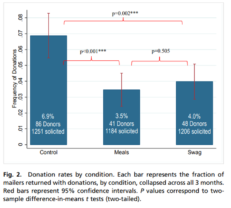Premiums (Can) Reduce Giving
To premium or not to premium, that is the /a question.
Wade into this debate at your peril as confirmation bias is powerful and seemingly no amount of evidence in one-direction is likely to sway opinion if you believe the counter view. In fact, you’ll likely dig in deeper in the face of counter-evidence.
So, both sides, prepare to dig in…
This is an experiment in public radio among existing donors (but “that’s not us”, “public radio is different”, “it isn’t applicable because of X, Y or Z”….says those who already use premiums).
This particular radio station offers conditional premiums (i.e. receive thank you gift if you give more than X) for their online giving and over-the-air fundraising. However, they had not done so in the mail prior to this experiment.
They took 12 month recent, house file donors and divided them into three groups for their member renewal campaign.
- Control – no conditional premium offer
- Traditional Premium – get an insulated tumbler if give over $X.
- Non-traditional Premium – station will donate 60 meals to local food bank of give over $X.
The results?

The traditional and non-traditional premium greatly reduced response rate and total dollars raised (as neither test condition increased average gift). As usual, the more valuable insight is cause and effect, not superficial outcome.
In this case the suppression of giving in the premium test conditions was largely among donors who gave more money in the prior year. Why is that? The higher previous giving is a proxy for donors who have more intrinsic, innate and volitional reasons for support.
In short, the premiums changed the mental calculus for the best donors (those giving above the median the prior year) and turned them from high quality motivation donors to non-donors. Giving among those who gave less than the median the prior year was not statistically, significantly different from the control – hence in this instance, the premium was all downside and no upside.
The “swag” condition is a function of crowding out intrinsic reasons for extrinsic ones and in this case, the extrinsic motivator wasn’t nearly good enough to match much less exceed the intrinsic motivation. This is also evidence that motivation quality matters more than quantity and that the quality of motivation felt by your donors is under your control.
But what about the meals offer? Why did that suppress giving? This wasn’t intended to change the mental calculus by crowding out “good” motivators with “bad”, external ones. But, it appears this did happen. The researchers surmise the colorful insert promoting this offer drew disproportionate attention away from the letter copy that was highlighting (and reminding of all the) intrinsic reasons to give.
This attention deficit from the intrinsic motivations was all it took to suppress giving.
Kevin



Fascin ating research. Of course, one would have to test for oneself. But chalk one up for the value of testing!
Claire, thanks for the feedback. I’d modify slightly and add that we chalk one up to the value of testing when using theory and science as the guideposts for what to test and why and what to expect by way of educated guess/prediction/hypothesis on outcome. One thing we know for sure, no test result will ever perfectly match the control. Most of the difference most of the time is just random, noise. The likelihood of it being noise goes up exponentially if the test idea had no ‘reason to believe’ behind it.